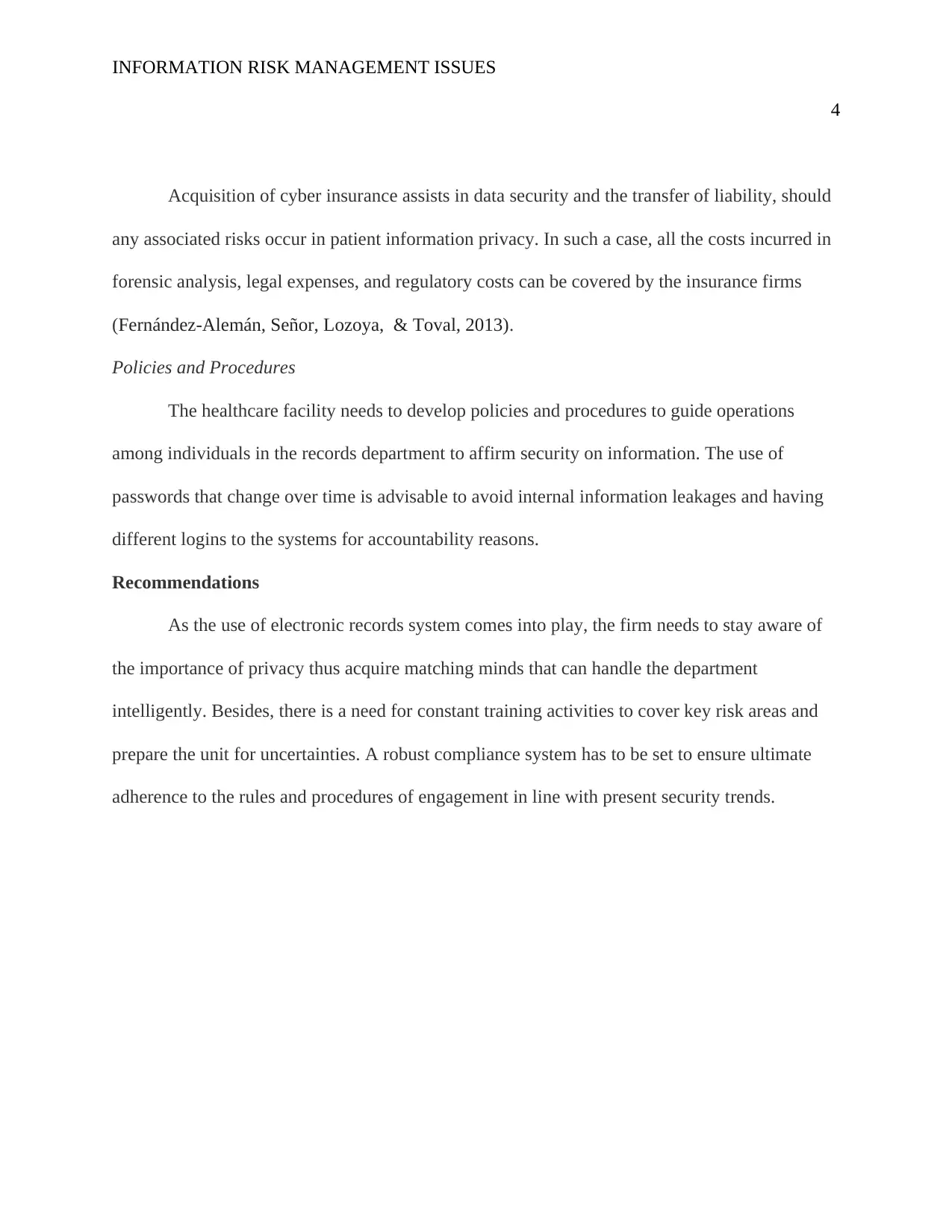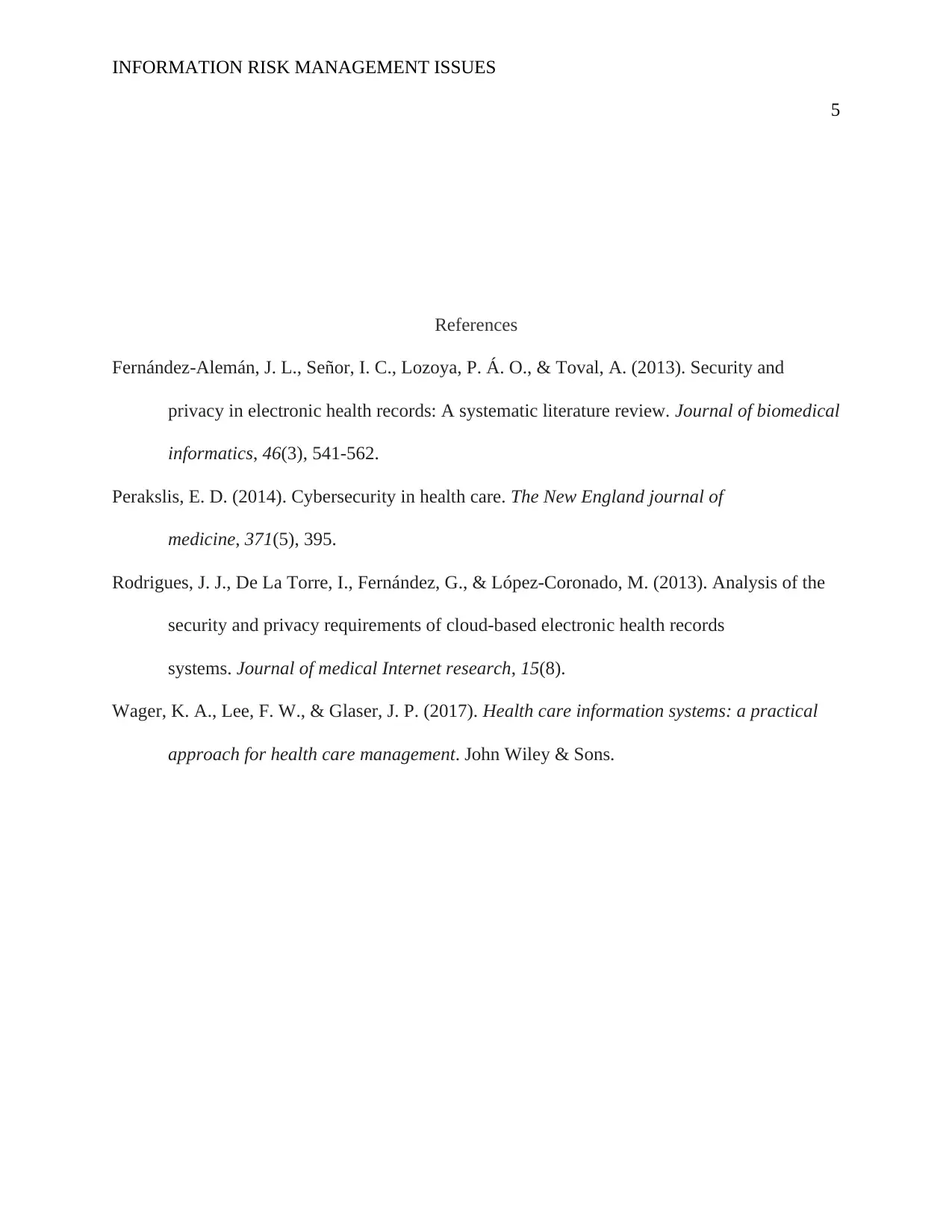Risk Management Issues and Solutions in Healthcare Records System
VerifiedAdded on 2019/11/25
|5
|916
|178
Report
AI Summary
This report addresses the critical issue of information risk management within the healthcare sector, focusing on the shift to electronic health records and the associated cyber threats. It highlights the vulnerabilities of healthcare systems to cybercrime, potentially leading to data breaches, financial losses, and reputational damage. The report emphasizes the importance of proactive risk management strategies, including collaboration with insurance carriers for risk assessment, training of IT staff, implementing data backup systems, acquiring cyber liability insurance, and developing robust policies and procedures. Recommendations include constant training, robust compliance systems and awareness of privacy issues. The report provides insights into mitigating risks and ensuring the security and confidentiality of patient information, referencing key literature in the field.

Running head: INFORMATION RISK MANAGEMENT ISSUES 1
Information Risk Management Issues
Name
Institution
Information Risk Management Issues
Name
Institution
Paraphrase This Document
Need a fresh take? Get an instant paraphrase of this document with our AI Paraphraser

INFORMATION RISK MANAGEMENT ISSUES
2
Information Risk Management Issues
Introduction
Risk management is an important consideration in the healthcare sector as it touches on
the information security aspect of a healthcare system. One of the risk elements outlined in the
local health facility was the issue of information security and the threat of cyber crime. The
healthcare industry is adapting the current wave of electronic healthcare records moving away
from the manual storage which consumed space and time to retrieve. However, the present
development comes with the threat of cyber crime where cyber criminals might hack the
information and shut down the health-related systems. The information and technology
department of the hospital remains the concerned parties in the risk management plan.
Information and Data Risk Management
Interruptions and breaches on network system of the healthcare facility can lead to the
jeopardy of an organization’s security system, reputation, and financial standards. The firm lacks
the necessary policies to guarantee information security which can affect its operations and the
confidentiality of patient information. Cyber crime affects several industries using information
technology systems thus putting the healthcare organization at risk.
According to (Wager, Lee & Glaser, 2017), competitors and other individuals out to spoil
the reputation of a given hospital can use the cyber criminals to destroy patient information or
altering the same thus putting the patients in danger as well as the facility. Consequently, the risk
can lead to financial costs from court battles from patients and other regulatory fines due to the
lack of compliance by the organization (Perakslis, 2014). As such, the risk of cyber security
becomes a real threat to the healthcare industry in the present day operations.
2
Information Risk Management Issues
Introduction
Risk management is an important consideration in the healthcare sector as it touches on
the information security aspect of a healthcare system. One of the risk elements outlined in the
local health facility was the issue of information security and the threat of cyber crime. The
healthcare industry is adapting the current wave of electronic healthcare records moving away
from the manual storage which consumed space and time to retrieve. However, the present
development comes with the threat of cyber crime where cyber criminals might hack the
information and shut down the health-related systems. The information and technology
department of the hospital remains the concerned parties in the risk management plan.
Information and Data Risk Management
Interruptions and breaches on network system of the healthcare facility can lead to the
jeopardy of an organization’s security system, reputation, and financial standards. The firm lacks
the necessary policies to guarantee information security which can affect its operations and the
confidentiality of patient information. Cyber crime affects several industries using information
technology systems thus putting the healthcare organization at risk.
According to (Wager, Lee & Glaser, 2017), competitors and other individuals out to spoil
the reputation of a given hospital can use the cyber criminals to destroy patient information or
altering the same thus putting the patients in danger as well as the facility. Consequently, the risk
can lead to financial costs from court battles from patients and other regulatory fines due to the
lack of compliance by the organization (Perakslis, 2014). As such, the risk of cyber security
becomes a real threat to the healthcare industry in the present day operations.

INFORMATION RISK MANAGEMENT ISSUES
3
Steps and Analysis to Risk Management on Healthcare Records
Risk management calls for adequate measures to safeguard the information and ensure
little or no threats to information alteration. As such, several steps have to be initiated and
launched to protect information while staying away from the cyber criminals.
Insurance Carriers
The firm needs to work in close collaboration with the insurance carriers for the
assessment of exposure levels to provide consultancy on the effective management strategies.
Insurance companies cover damages occasioned to hacking and information loss thus can offer
essential guidance on safeguarding and closing all loop holes accredited to healthcare
information disturbances.
Training
The medical facility needs to obtain top-notch training for its information technology
officers to ensure compliance with the latest trends in data handling. Consultants and experts in
information protection ought to be brought in periodically to update and train them on the most
recent considerations and steps to avoid data damage. In so doing, the firm would remain
protected thus avoiding losses occasioned to information loss.
Information Backup
Storage of information in one provider or server proves to be difficult in case of a cyber
crime thus bringing difficulties in data retrieval. Rodrigues, De La Torre, Fernández & López-
Coronado, 2013). Suggest that providing a backup system is prudent towards protecting
information that can be presented and updated once a threat to the network is detected.
Cyber Liability Insurance
3
Steps and Analysis to Risk Management on Healthcare Records
Risk management calls for adequate measures to safeguard the information and ensure
little or no threats to information alteration. As such, several steps have to be initiated and
launched to protect information while staying away from the cyber criminals.
Insurance Carriers
The firm needs to work in close collaboration with the insurance carriers for the
assessment of exposure levels to provide consultancy on the effective management strategies.
Insurance companies cover damages occasioned to hacking and information loss thus can offer
essential guidance on safeguarding and closing all loop holes accredited to healthcare
information disturbances.
Training
The medical facility needs to obtain top-notch training for its information technology
officers to ensure compliance with the latest trends in data handling. Consultants and experts in
information protection ought to be brought in periodically to update and train them on the most
recent considerations and steps to avoid data damage. In so doing, the firm would remain
protected thus avoiding losses occasioned to information loss.
Information Backup
Storage of information in one provider or server proves to be difficult in case of a cyber
crime thus bringing difficulties in data retrieval. Rodrigues, De La Torre, Fernández & López-
Coronado, 2013). Suggest that providing a backup system is prudent towards protecting
information that can be presented and updated once a threat to the network is detected.
Cyber Liability Insurance
⊘ This is a preview!⊘
Do you want full access?
Subscribe today to unlock all pages.

Trusted by 1+ million students worldwide

INFORMATION RISK MANAGEMENT ISSUES
4
Acquisition of cyber insurance assists in data security and the transfer of liability, should
any associated risks occur in patient information privacy. In such a case, all the costs incurred in
forensic analysis, legal expenses, and regulatory costs can be covered by the insurance firms
(Fernández-Alemán, Señor, Lozoya, & Toval, 2013).
Policies and Procedures
The healthcare facility needs to develop policies and procedures to guide operations
among individuals in the records department to affirm security on information. The use of
passwords that change over time is advisable to avoid internal information leakages and having
different logins to the systems for accountability reasons.
Recommendations
As the use of electronic records system comes into play, the firm needs to stay aware of
the importance of privacy thus acquire matching minds that can handle the department
intelligently. Besides, there is a need for constant training activities to cover key risk areas and
prepare the unit for uncertainties. A robust compliance system has to be set to ensure ultimate
adherence to the rules and procedures of engagement in line with present security trends.
4
Acquisition of cyber insurance assists in data security and the transfer of liability, should
any associated risks occur in patient information privacy. In such a case, all the costs incurred in
forensic analysis, legal expenses, and regulatory costs can be covered by the insurance firms
(Fernández-Alemán, Señor, Lozoya, & Toval, 2013).
Policies and Procedures
The healthcare facility needs to develop policies and procedures to guide operations
among individuals in the records department to affirm security on information. The use of
passwords that change over time is advisable to avoid internal information leakages and having
different logins to the systems for accountability reasons.
Recommendations
As the use of electronic records system comes into play, the firm needs to stay aware of
the importance of privacy thus acquire matching minds that can handle the department
intelligently. Besides, there is a need for constant training activities to cover key risk areas and
prepare the unit for uncertainties. A robust compliance system has to be set to ensure ultimate
adherence to the rules and procedures of engagement in line with present security trends.
Paraphrase This Document
Need a fresh take? Get an instant paraphrase of this document with our AI Paraphraser

INFORMATION RISK MANAGEMENT ISSUES
5
References
Fernández-Alemán, J. L., Señor, I. C., Lozoya, P. Á. O., & Toval, A. (2013). Security and
privacy in electronic health records: A systematic literature review. Journal of biomedical
informatics, 46(3), 541-562.
Perakslis, E. D. (2014). Cybersecurity in health care. The New England journal of
medicine, 371(5), 395.
Rodrigues, J. J., De La Torre, I., Fernández, G., & López-Coronado, M. (2013). Analysis of the
security and privacy requirements of cloud-based electronic health records
systems. Journal of medical Internet research, 15(8).
Wager, K. A., Lee, F. W., & Glaser, J. P. (2017). Health care information systems: a practical
approach for health care management. John Wiley & Sons.
5
References
Fernández-Alemán, J. L., Señor, I. C., Lozoya, P. Á. O., & Toval, A. (2013). Security and
privacy in electronic health records: A systematic literature review. Journal of biomedical
informatics, 46(3), 541-562.
Perakslis, E. D. (2014). Cybersecurity in health care. The New England journal of
medicine, 371(5), 395.
Rodrigues, J. J., De La Torre, I., Fernández, G., & López-Coronado, M. (2013). Analysis of the
security and privacy requirements of cloud-based electronic health records
systems. Journal of medical Internet research, 15(8).
Wager, K. A., Lee, F. W., & Glaser, J. P. (2017). Health care information systems: a practical
approach for health care management. John Wiley & Sons.
1 out of 5
Related Documents
Your All-in-One AI-Powered Toolkit for Academic Success.
+13062052269
info@desklib.com
Available 24*7 on WhatsApp / Email
![[object Object]](/_next/static/media/star-bottom.7253800d.svg)
Unlock your academic potential
Copyright © 2020–2025 A2Z Services. All Rights Reserved. Developed and managed by ZUCOL.





